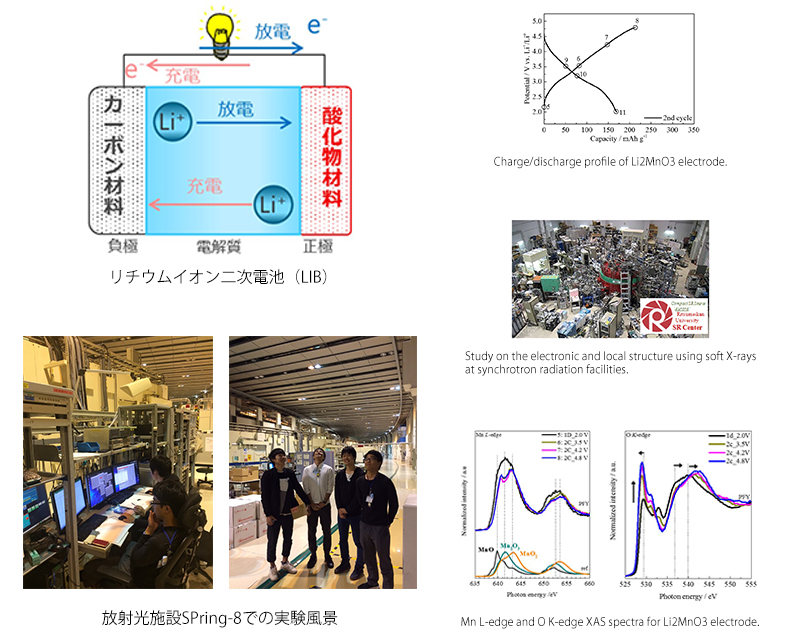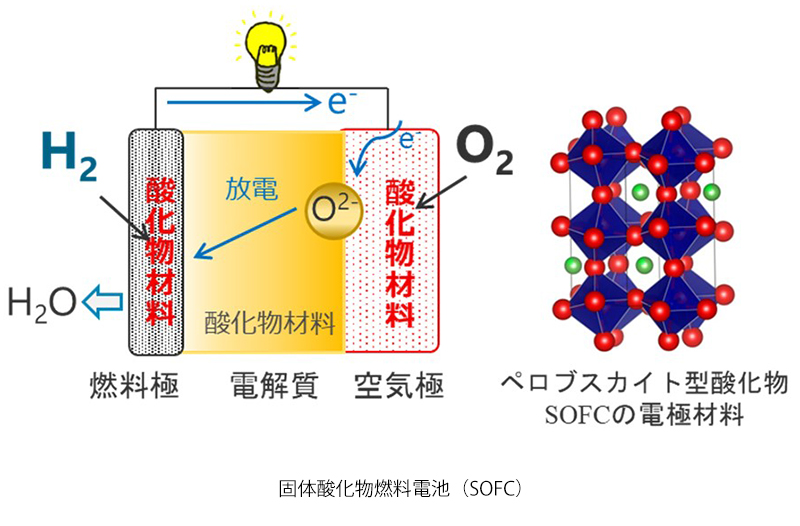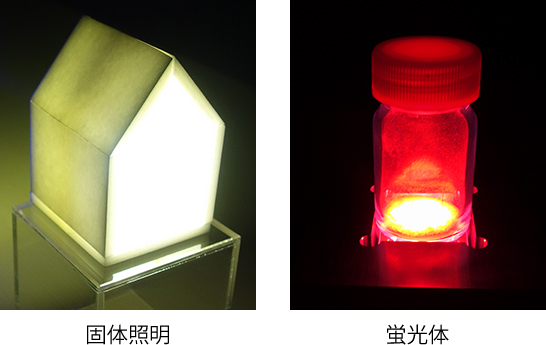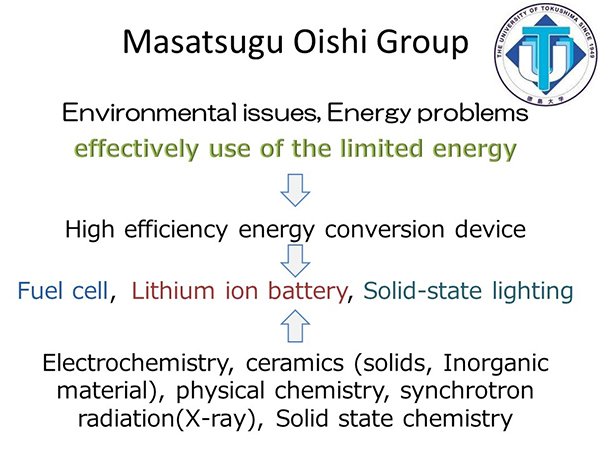
Reasearch
概要

固体イオニクス
固体内に積極的に欠陥導入を行い材料物性制御(イオン・電子導電性、機械特性、触媒特性など)を達成する。
固体イオニクス、欠陥化学、電気化学をベースにして研究を行っている。

リチウムイオン二次電池
化学エネルギーを電気エネルギーに変換する化学電池の中で、充電放電により繰り返し使うことができる蓄電池が二次電池です。その中でも、リチウムイオン電池(Lithium Ion Battery, LIB)は、高いエネルギー密度を示します。次世代LIBとして更なる性能向上を目指して、高容量正極材料の結晶構造及び電子構造(放射光を用いた測定)に関する研究を行います。また次世代の二次電池として全固体電池が注目されており、その構成材料の機械強度に関する研究にも取り組んでいます。

固体酸化物形燃料電池
化学エネルギーとしての水素燃料を連続的に供給して、発電する化学電池が燃料電池です。水素を用いることで、発電時に排気されるのは“水”のみであり、究極の発電システムです。固体酸化物形燃料電池(Solid Oxide Fuel Cell: SOFC)は高温で作動することから、高い発電効率を示します。SOFCは、セラミックス材料で構成されており、この固体中のイオン(酸素イオン、プロトン)の移動現象は、固体内の欠陥構造に大きく依存します。そこで、固体内への積極的な欠陥導入による材料物性制御を実現し、今までにない材料創製を目指した研究を行います。

固体照明の蛍光体材料
白熱ランプや蛍光灯の照明と比べて、高いエネルギー変換効率を示す固体照明が急激に普及してきました。固体照明では、光を出す配光部に蛍光体であるセラミックス材料が用いられています。今後、固体照明の更なる普及に伴い、高温雰囲気など今まで使用を想定していなかった過酷な環境での利用も想定されます。高温熱劣化メカニズムの解明に向けた蛍光体材料の電子状態及び結晶構造解析、また劣化抑制を目指した被覆処理技術開発に関する研究に取り組んでいます。蛍光体配光部の質的向上を達成することで、高付加価値の照明技術開発を目指します。

Overview

Solid Ionics
We actively introduce defects into solids to control the material property (ion / electron conductivity, mechanical properties, catalyst properties etc). Our research is based on solid ionics, defect chemistry, and electrochemistry.

Lithium Ion Battery
Among chemical batteries that convert chemical energy into electric energy, secondary batteries are rechargeable batteries that can be used repeatedly by charge and discharge. Among them, Lithium Ion Battery (LIB) shows high energy density. We are working on the researches on the crystal structure (XRD, Pair distribution Functional) and electronic structure (using synchrotron radiation, X-ray Absorption Spectroscopy) of high capacity positive electrode material for next generation LIB. All-solid-state batteries are attracting attention as next-generation secondary batteries, and we are also working on research on the mechanical strength of the constituent materials.

Solid Oxide Fuel Cell
Fuel cells are chemical cells that continuously generate hydrogen fuel as chemical energy and generate electricity. By using hydrogen, only "water" is exhausted during power generation, hence it is the ultimate power generation system. Solid Oxide Fuel Cell (SOFC) operates at the high temperatures, and it shows high efficiency. SOFC is composed by ceramic materials, and the transport phenomenon of ions (oxygen ions, protons) and electrons in the solids depends on the defect structures in the solid. We are intended to control the material property by actively introducing defects into the solids, and researches are aimed to newly create materials or advanced functions.

Solid State Lighting
Compared to the conventional lightings such as incandescent lamps and fluorescent lamps, solid state lighting such as LED lamp shows high energy conversion efficiency and it has become widespread. In solid-state lighting, a ceramic material, a phosphor, is used for the light distribution part that emits light. We are engaged in researches on the electronic and crystal structure analysis of the phosphor materials to elucidate the high temperature thermal degradation and the development of the coating treatment technology. We are aiming to develop tailor made distribution light emitting units to add new values to the solid state lightings using ceramic technology.
